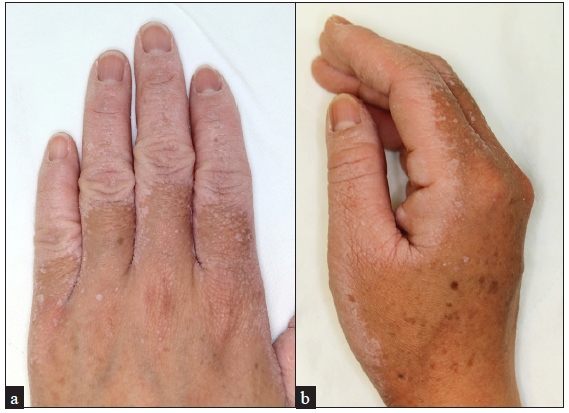Translate this page into:
Nagashima-type palmoplantar keratoderma
Corresponding author: Dr. Cheng-Yuan Li, Department of Dermatology, Taipei Veterans General Hospital, Taipei, Taiwan. proteinm@yahoo.com.tw
-
Received: ,
Accepted: ,
How to cite this article: Chen T-L, Li C-Y. Nagashima-type palmoplantar keratoderma. Indian J Dermatol Venereol Leprol. 2025;91:410-1. doi: 10.25259/IJDVL_1214_2024
A 38-year-old woman presented with a history of asymptomatic erythema and thickening of palms and soles since she was six years old. The condition has been stable without any progression. There was no family history of similar lesions. A skin examination showed diffuse, well-demarcated, erythematous palmoplantar hyperkeratosis with transgradient erythema extending to dorsal surfaces of hands [Figures 1a and 1b], feet and inner wrists. A whitish spongy appearance of lesional skin was noted after a ten-minute water exposure [Figure 2a and 2b]. Dermoscopy revealed the spongiotic and edematous dermatoglyphics after water immersion. Genetic testing showed a nonsense mutation in the SERPINB7 gene. The diagnosis of palmoplantar keratoderma, Nagashima type, was made. Differential diagnoses considered included aquagenic syringeal acrokeratoderma, which is a dermatosis limited to the palms and can also present with whitish papules and wrinkles on the palms after water exposure.

- (a) Diffuse, well-demarcated, erythematous palmoplantar hyperkeratosis with transgradient erythema extending to dorsal hands. (b) Lateral view.

- (a) Whitish spongy appearance of lesional skin was noted after a 10-minute water exposure. (b) Lateral view.
Acknowledgement
The authors thank Dr. Wei-Ting Tu (Department of Dermatology, National Cheng Kung University Hospital, College of Medicine, National Cheng Kung University, Tainan, Taiwan) for for assistance with genetic testing.
Declaration of patient consent
The authors certify that they have obtained all appropriate patient consent.
Financial support and sponsorship
This study received funding from National Cheng Kung University Hospital research grant (NCKUH-11104017).
Conflicts of interest
There are no conflicts of interest.
Use of artificial intelligence (AI)-assisted technology for manuscript preparation
The authors confirm that there was no use of artificial intelligence (AI)-assisted technology for assisting in the writing or editing of the manuscript and no images were manipulated using AI.





